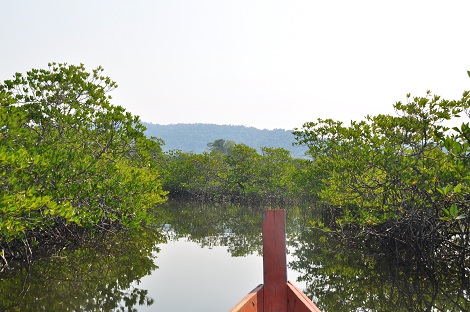As we had a few weeks off during this February, we got
totally excited about the part that took us on an 8 day trip into Cambodia. A country
that by the looks of it combines great natural areas – with significant importance
to the whole region of South East Asia – with a stunning coast that is dotted
with tropical islands and endless stretches of pristine beaches.
The coast around charming Sihanoukville means nothing less than sheer pleasure. Everything you might need on a beach and much more is within easy distance of your sunbed. Yes the Cambodians know what hospitality means, no doubt about that!
Thinking of where to visit nature we decided to venture out
on a trekking through part of Cardamom Mountains. Made up out of different
protected areas, these mountains still harbour huge quantities of intact forest
with even more unbelievable wildlife of which most I would have never thought
to be present in Asia. Indo Chinese tigers, clouded leopards, asian wild dogs, forest
elephants, gibbons and the list continues. Big mammals comparable to those around
Lamai Serengeti.
Sadly with one significant difference.
We accessed the foot of the mountains via boat through beautiful mangroves. Though not more than half a day into out trekking it became sadly clear that all of this magnificent flora and fauna is severely threatened - as is the forest in which they live.
.
Threatened to such an extend that both Suzanne and I were outright shocked by the complete absence of any sign of wildlife during the trekking. Over one full day of trekking not more than two birds, three species of butterfly and one fantastic insect was identified.
Talking with our guide made painfully clear that the vast hunger for exotic mammal species of neighbouring countries and extreme poverty of local people all rapidly changed the forest over the past 3 years. Combined with a ferocious corruption on illegal logging, our own guide couldn’t believe this place would still be here in 10 - 15 years from now.
Trees without monkeys
or birds, general absence of any bigger mammal and dams that had cut vital rivers.
A sad story about one of the few remaining but rapidly decreasing bio diversity
hotspots in Cambodia. Never before was it so outright clear to us how
destructive man can be to nature. And never it was so clear we should cherish
the wildlife areas as we know them.
So now let’s take a big step back to Lamai Serengeti. As we flew
into the northern Serengeti yesterday the sheer size of this massive 33.000 sq.km
(and relatively well -) protected area is of great importance and joy. The
incredible wildlife that we had seen from the plane and within the 30 minute
drive from the airstrip back to Lamai Serengeti, was unbelievable. Sounds and
bush all around you – birds, monkeys, zebras, insects and simply fantastic smells.
We hope the Cardamoms and its inhabitants will survive.
























